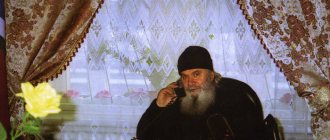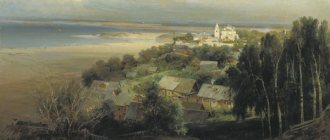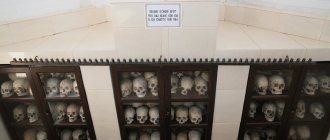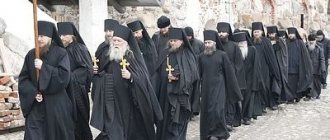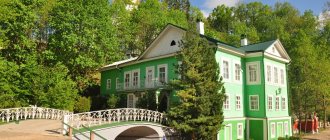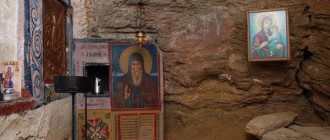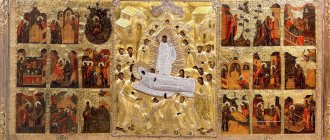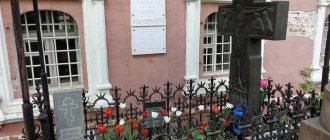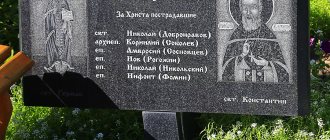Pskov-Pechersky Monastery. Far Caves
In the Holy Caves you feel such grace that you want to come back here again and again. I was lucky enough to visit the caves five times over the course of a month.
For the last time, falling behind the group, I turned along the familiar turn to Father John (Krestyankin) to say goodbye to him.
Later, my neighbor in the cell, Anya, said that she did not notice how I fell behind, lost me and, frightened, turned to the monk leading the group through the cave: “Olya has fallen behind, she will get lost!” To which the monk, smiling, replied: “Well, eleven thousand people are buried here. One person more, one person less..."
This is, of course, a joke. The brothers know the cave city well, and will not allow anyone to get lost. But you can really get lost here. It's worth leaving behind the group. And if the candle flame, trembling from the flow of air, goes out, then everything around will be plunged into impenetrable darkness.
And you will be able to walk through the caves for a long time, holding onto the walls with your hands, moving by touch along the cave streets. And there are seven streets here. Two are short, five are long.
They have names and resemble the ancient catacombs of the first Christians.
There are Main, Bratskaya and Malaya Bratskaya streets, Startsev or Kormchaya streets. There is Tserkovnaya Street, leading to the temple in honor of the Resurrection of Christ.
The walls, ceiling, floor of the cave streets are all sandy. They say that a professor of soil science who came here entered the caves and ran out of them very quickly. He was excited and explained to those present that they did not understand how wonderful these caves were. But he, as a professor, understands well that the sandy ceiling simply cannot help but crumble. And he will not enter the caves again, this miracle is too incredible for him!
Burials in caves are carried out in burial niches. Currently, the inhabitants of the monastery who served God in the priesthood find their resting place here.
Part of the walls was lined with brick in the 19th century.
I touch the walls with my hands, I feel not sand, but stone. I bring the candle closer - these are ceramides - tombstones. Each of them is a certificate of the deceased and a monument of ancient Russian art.
Ceramides - tombstones - stone or ceramic (clay). The images on them are in relief, some are covered with glazes, and there are ornaments. There are multi-colored ceramides. The earliest ceramic tombstone dates from 1530.
Despite the huge number of buried people - if you look into the niches, you can see the coffins - there is no smell of decay. On this occasion, the monk who conducted the tour told us about Nikita Khrushchev’s visit to the caves. How he asked the monks why there was no smell of decay here. One of the monks asked him a counter question: “There are many people accompanying you, tell me, is there any smell coming from them?” Khrushchev was indignant: “What other smell could there be from them? This is my retinue! “And here lies the retinue of the Heavenly King,” answered the Pechersk monk.
Yes, here lies the retinue of the Heavenly King - I think, touching the tombstones. Archimandrite Afinogen (in schema Agapit), Archimandrite Alypius (Voronov), Schema-Archimandrite Alexander (Vasiliev), Archimandrite Dosifei (Sorochenkov), Hieroschemamonk Simeon (Zhelnin), Archimandrite Seraphim (Rosenberg), Archimandrite Nathanael (Pospelov), Archimandrite John (Krestyankin) - When I read about these people in Pechersk leaflets, tears flowed down my cheeks.
I felt sorrow and joy at the same time. Grief because I didn’t get to see these lamps of God. Joy because I was lucky enough to visit and pray at their resting place. And realize that everyone is alive with God!
Hieroschemamonk Simeon (Zhelnin) (1869–1960) - a famous ascetic and man of prayer, had from God the gifts of insight and grace-filled prayer. He was canonized in 2003. This lamp of God shone in the monastery for more than 60 years. “Like an ancient ascetic, adorned with reverence,” is sung about him in the troparion.
During the war, the Germans demanded that all the inhabitants of the monastery be evacuated to Germany. It was supposed to take the monks out and blow up the monastery. Elder Simeon led the monks in prayer for their native monastery. The fervent prayer lasted all night. And this prayer turned out to be stronger than the plans of the invaders.
After the war, during the persecution of the atheistic authorities, fertile lands - crops and vegetable gardens - were taken away from the monastery, and in return they were allocated lands behind the monastery. On these new lands the crops did not germinate. The Pechersk leaflet tells how Elder Simeon, who knew about this in spirit, secretly went to those lands and prayed. Through his prayers, the Lord sent shoots and a bountiful harvest.
After canonization, the elder’s relics were transferred to the Sretensky Church of the monastery. And in his place now rests my beloved elder, Father John (Krestyankin).
Archimandrite John Krestyankin lived a long life. And he dedicated it all, like a true shepherd, to his flock. There are always huge and beautiful bouquets of fresh flowers at his resting place. And no matter how many times I came to his coffin, the flowers were always fresh.
His heart was infinitely loving and merciful. This is the love that can be acquired only by grace, the love that “lays down his life for his friends.”
Later, I visited his cell, sat on the sofa where the priest was sitting, and met his cell attendant Tatyana Sergeevna Smirnova. I remember her words about Father John.
Knowing that this was an old man in front of her, she nevertheless could not at first believe in his love for people. This love was so great and all-encompassing that the embarrassed cell attendant thought: “It is impossible to love people so much. Maybe the priest is acting?
She told me about this with a smile - the temptation went away - and she saw: yes, this is true love. We just don’t know how to love like that without God’s grace. This is God's gift.
“Love is long-suffering, merciful, love does not envy, love does not exalt itself, is not proud, does not act outrageously, does not seek its own, is not irritated, does not think evil... Love never ceases...” We can talk for a long time about the priest’s insight and his gifts.
I spent a whole hour at his coffin. And I didn’t notice this time. It seemed to me that I was talking with a living person. By stretching your hand into the niche, you can touch the priest’s coffin.
When Tatyana Sergeevna blessed me with books about Father John, his photographs and even a chocolate bar, I had the feeling that I had accepted these gifts from the hands of the priest himself.
Archimandrite Afinogen (in the schema Agapit) (1881–1979) belonged to the true flower of the Pskov-Pechersk eldership. He is described in the Pechersk leaflet as a simple-hearted and loving monk who possessed the special power of prayer.
Meek and quiet, in the most difficult years of his life, in camps and exile, he relied on the will of God and was strengthened by prayer. He was a fraternal confessor, chastised those possessed by demons, and was awarded high spiritual gifts and insight.
Already approaching the centenary mark, the elder easily climbed the steep stairs of St. Michael's Cathedral, every day he walked through the monastery garden on Holy Hill, saying the Jesus Prayer.
He had an amazing gift of tears; he could cry all day long from tenderness before God’s love for “the world lying in evil,” from grief for his own sins and even mourning the sins of all mankind.
Archimandrite Alipiy (Voronov) (1914–1975) is an outstanding abbot of the monastery. Participant of the Great Patriotic War. Since 1942, he fought in the active army, marched the entire front to Berlin, and was awarded medals and orders. He took monastic vows after the war at the Trinity-Sergius Lavra, and since 1959 he has been the abbot of the Pskov-Pechersky Monastery.
He was a shepherd with confessional steadfastness and fortitude. The Pechersk leaflet tells how, during times of persecution, he burned a paper about the closure of the monastery right in front of the envoys of the atheistic authorities.
Father Alipius told them: “It would be better for me to accept martyrdom, but I will not close the monastery.” And the monastery was not closed!
And when they came to take away the keys to the caves, Archimandrite Alypiy commanded the cell attendant: “Father Cornelius, give us an ax here, we’ll chop off heads!” Those who came fled.
The story of how it was forbidden to serve memorial services in caves is well known. But Father Alypius replied to those who forbade that their decree was written under pressure, due to weakness of spirit. And “I don’t listen to the weak in spirit, I listen only to the strong in spirit.” And the service of memorial services was never interrupted. It continues today. And I was lucky enough to attend these funeral services.
During one of the most difficult periods for the monasteries and the entire church, when Khrushchev said in an interview that he would soon show the last priest on TV, Archimandrite Alypiy managed to restore the walls enclosing the monastery from almost ruins. He restored and restored the monastery, supported the icon-painting traditions of the monastery. He painted the icons himself.
His strength of spirit was such that if he had sighs and tears during prayer and preaching, then all those praying cried with him.
Schema-Archimandrite Alexander (Vasiliev) (1927–1998). His fate is a vivid example of how God protects his chosen ones. During the fascist occupation, young people were driven away to work in Germany. And they didn’t take him alone, freeing him from any work at all. And only he was the only one wearing a pectoral cross. The Lord protected the future monk. Father Alexander, on behalf of the elders, kept the shrines of the Diveyevo Monastery for 35 years. And he transferred them to Diveevo in 1992, when the monastery became operational.
He was a fraternal confessor. He also loved to do everything with his own hands. He sat behind the wheel of a tractor and worked harvesting vegetables. In the apiary. When, on the day of his 70th birthday, the abbot of the monastery, Archimandrite Tikhon, asked him: “Father, what was the happiest day in your life?” - Father Alexander replied: “The day when I serve the Divine Liturgy.”
Archimandrite Dosifei (Sorochenkov) (1928–1998) was accepted into the brotherhood of the monastery in 1957, and from 1966 to 1982, that is, 16 years, he lived on Mount Athos, in the Russian St. Panteleimon Monastery.
Returning from the Holy Mountain, Father Dosifei showed the brethren an example of asceticism. His main activity was prayer. Where everyone had a hallway in their cells, he had a bed and a wardrobe. And the entire remaining space was intended for prayer - in the middle there was a lectern, with icons all around.
Until the last day, overcoming severe pain in his legs, he went to the Divine Service. Sometimes this journey took up to two hours!
When I read about this, I wanted to cry. I remembered how the reason for me not to go to service was a slight cold or slight malaise.
These are the elders who lie in the Far Caves. And how many unknown monks, monastery builders, prayer books, defenders of the monastery are here! Fathers of Pskov - Pechersk, pray to God for us!
Dormition in Pechory (PHOTO + VIDEO)
The Dormition of the Mother of God is one of the most touching holidays of the Orthodox Church; it combines quiet sorrow, bright sadness about the death of the Mother of God and the joyful triumph of victory over death.
The Most Pure Mother of Jesus ascends to Her Son... In honor of the Feast of the Assumption, many churches, cathedrals and monasteries were erected in Russia. In the last days of August, thousands of pilgrims and tourists come to the city of Pechory on the border with Estonia to experience the mysterious celebration of the Dormition of the Virgin Mary in the famous Pskov-Pechersky Monastery. On the eve of the Dormition of the Virgin Mary, we go along the highway, through Tver and Novgorod, to Pskov. Our destination is a small border town in northwestern Russia. We have been to the Pskov-Pechersky Monastery before, but for the Assumption - for the first time...
There is a touching tradition in Pechory. The Pecheryans decorate the entire road up the mountain, along which the miraculous icon of the Assumption will walk in procession, with fresh hay and wildflowers. Hundreds and thousands of flowers! The caring hands of women and children “embroider” a living carpet - huge, colorful and fragrant.
Pskov-Pechersky Monastery. From here it’s a stone’s throw to the border with Estonia, just a couple of kilometers. Pechory is the westernmost city in Russia, not counting Kaliningrad. But unlike the former Koenigsberg, Pechory is a historically Russian city. Even by name: from the ancient “pechera”, that is, “caves”.These caves are one of the main attractions of the monastery. They were discovered at the end of the 14th century by the peasant Ivan Dementyev. When he was cutting down a forest on the mountainside, an underground passage opened under the roots, and above it was the inscription: “Caves created by God,” that is, created by God. According to legend, people from the Kiev Pechersk Lavra once lived in this place.
In 1473, in a hill near the caves, an underground church was dug and consecrated in honor of the Dormition of the Mother of God. This is how the famous Assumption Pskov-Pechersky Monastery was founded.
August 27. The all-night vigil for the Feast of the Assumption takes place in the open air. Together with Metropolitan Tikhon (Shevkunov) of Pskov and Porkhov, the service is performed by Metropolitan Hilarion (Alfeev) and several bishops from Serbia.
The service in Pechory is divided into several locations. Vespers, according to a long-standing tradition, is celebrated on the lower square, in front of the caves and the Assumption Church. At the end of the litiya there is a religious procession.
The main shrine of the monastery - the ancient image of the Dormition of the Mother of God, supported by dozens of strong hands - seems to be floating along a carpet of flowers, slowly and smoothly ascending the mountain.
Matins will take place upstairs. This evening service will end in the square in front of St. Michael's Church.
The Pskov-Pechersky Monastery has never been closed. Even in the most difficult times - terror and Bolshevik persecution, war and German occupation, Khrushchev's godlessness and Brezhnev's stagnation - monastic life glowed in this monastery. Pechory preserved the traditions of eldership and spiritual succession. Schema-Archimandrite Iliy (Nozdrin) left Pechory, and Elder Archimandrite John (Krestyankin), beloved by all of Russia, will serve here until the end of his days.
Father John Krestyankin will die in February 2006. Although the word “death” somehow doesn’t fit with him, he will simply leave. He will go into eternal life. On that frosty morning, our film crew was also present at the funeral service and funeral...
John Krestyankin will be buried in caves. 13 years have passed since then... There are still fresh flowers near him today, and memory in the hearts of his spiritual children.
Priceless memoirs and materials about Krestyankin’s life will begin to be published by his cell attendant, faithful assistant and clerk, Tatyana Sergeevna Smirnova. Perhaps everyone who came to Father John knew her.
Bishop Tikhon (Shevkunov), Metropolitan of Pskov and Porkhov, remembering Tatyana Sergeevna, smiles. She was loved...
“In the Church, especially in monasteries, there is such an experience,
” says Metropolitan Tikhon (Shevkunov) of Pskov and Porkhov, “ living next to saints is very difficult, this is a very difficult task. And not everyone can master it.
And Tatyana Sergeevna Smirnova, Elder John’s (Krestyankin’s) assistant and secretary for many years, she was just such a person who could understand the great confessor. Understand enough to become his real assistant! Become a real support for him. But this year the Feast of the Assumption will take place without her for the first time. Remembering Tatyana Sergeevna, Metropolitan Tikhon smiles and... feels sad. This spring, on May 6, Tatyana Smirnova went into Eternity, following her confessor, Father John...
-
Notice! - Vladyka Tikhon draws attention, - Father John chose not one of the brethren, the monks, but precisely this wonderful elderly woman icon painter, who was probably close to him in spirit. We appreciated her endlessly!
We talk with the ruler in the shade of old trees near the fortress walls. At some point I still ask a question that worries me:
“
Didn’t you, Vladyka, have the feeling that some piece of spiritual experience, a piece of the soul of Father John, was passed on to Tatyana Sergeevna?” - Well, of course! She communicated with him so much, saw the example of prayer and asceticism of Father John, and, of course, this could not help but be passed on to her.
For this they loved her, for this they appreciated her and were immensely grateful to her. She was such a guardian angel to Father John... Morning of August 28th. The culmination of the Feast of the Assumption is approaching. After the liturgy on St. Michael's Square, a grand religious procession begins around the monastery. To see this, to follow the revered image of the Dormition of the Mother of God a long way along the fortress walls - thousands of guests and pilgrims come to Pechory.
Located on the border between Russia and Livonia, during its history the Pskov-Pechersky Monastery was repeatedly attacked by the Germans, Livonians, Swedes and Poles. Still would! This was a spiritual outpost in the north-west of Rus'. In 1565, in order to secure the monastery, the monastery was surrounded by high walls and watchtowers. Since then, the Orthodox monastery will turn into an impregnable Pechersk fortress. Precisely unapproachable!
The uniqueness of the fortifications is in their location! Usually fortresses are built on a hill, like this one, in a gorge, between the hills. Below, under the tower, there is a stream - an excellent solution to the water problem during a siege.
And the Pechersk fortress was constantly besieged. At the end of the 16th century there was a months-long siege by the troops of King Stefan Batory. At the beginning of the 17th century there were sieges by the Polish troops of Jan Chodkiewicz and the Swedish troops of Gustav II Adolf. At the beginning of the 18th century, during the Northern War, the Swedes, led by Charles XII, tried to take the fortress twice. But unsuccessfully…
The chronicles specifically mention the siege of 1581. The huge army of Stefan Batory besieged Pechory. After shelling the monastery with guns, the Poles broke one of the walls. Mercenaries from all over Europe rushed into the gap... It seemed that the enemy could no longer be restrained... And then the monks brought the main shrine to the gap - the icon of the Dormition of the Mother of God...
The battle went on until late at night, but the fortress was never taken. The secretary of the marching office of King Batory, Jan Piotrovsky, will later write:
“The Germans are unlucky in Pechory, there were two assaults and both were unhappy. They'll make a hole in the wall, go for an attack, and then they won't move. This surprises everyone, some say that the place is enchanted, others that the place is holy... But in any case, the exploits of the monks are worthy of surprise.”
The procession around the monastery has ended, but the celebration is still ongoing. On the territory of the Pilgrimage Center of the Pskov-Pechersk Monastery, on the day of the Assumption, a unique Children’s Playground opens...
At the opening, Metropolitan Tikhon announces that the site is intended for all children, believers and non-believers, pilgrims and city residents. For kids - multi-level children's slides, swings and carousels. For adults - sports equipment, areas for workout, mini-football, basketball. Such a playground is just a dream for every child!
Having forgotten that the governor of the Pskov region and two rulers are nearby, many children in a matter of minutes stick around all the slides and carousels. Finding themselves in the Brownian movement of noisy children, Metropolitans Hilarion and Tikhon themselves smile. “Suffer the little children to come to Me, for of such is the Kingdom of Heaven”...
Evening of August 29. The finale of the Assumption of the Virgin Mary is coming. With a quiet, bright sadness in my heart. Dusk is falling on Pechory. Near St. Michael's Church there is an all-night vigil and the Rite of Burial. About five thousand people are anxiously awaiting the start of the last religious procession. Now back - down to Assumption Square, with the Shroud of the Mother of God.
Thousands of pilgrims will preserve this memory of the holy days of the Assumption for a long time, just like us, trusting in the Mother of God that someday She will bring us here again...
Alexander EGORTSEV Photo by the author
Elders of the Pskov-Pechersky Monastery and the Cathedral of Saints of the Pskov-Pechersky
Many monasteries have shone in Rus', but only a few have become known for their elders - this is the name given to righteous monks to whom the Lord granted insight and miracle-working during their lifetime, who receive all people, giving advice to everyone.
The tradition of eldership in the Pskov-Pechersky Monastery continues, but many of them have already been canonized as saints - after all, the monastery has an ancient history. It has never been closed, despite many historical vicissitudes. The monastery is beautiful both in its spiritual life and beautiful in appearance: masterpieces of architecture and icon painting dating back five hundred to six hundred years have been preserved here, and great shrines are carefully revered.
The Cathedral of the Reverend Fathers of Pskov-Pechersk is an image of the great holy ascetics who lived quite recently. These are ascetics and prayer books for all people, who did not leave anyone without consolation. In their prayer experience and help - God's grace, faith, wisdom and understanding of the purpose of every person in this world. After all, today it is difficult to understand where to apply yourself among the many possibilities, how to act in a given situation.
Caves of the Pskov-Pechersky Monastery
The full name of the monastery is the Holy Dormition Pskovo-Pechersky, and it has such a special name thanks to the ancient word “pechery”, that is, caves. In the Pskov-Pechersky Monastery they are called “God-created”, that is, “created”.
This is a unique natural formation. The first and main church of the monastery is called the Assumption and was consecrated in honor of this holiday in 1473 by the Monk Jonah, the founder of the monastery. He came here from the lands of modern Estonia (Tartu) hiding from attacks by Catholic Germans on Orthodox Christians. Saint Jonah was a married priest and at first lived with his wife. Soon both of them accepted monasticism - the tomb of Saint Jonah’s wife is also located in the “God-created” caves. She was canonized as Saint Vassa.
They lived and prayed in the caves they found, and after the founding of the temple and monastery by Saint Jonah, the mountain in which the caves are located received the name “Holy”. Traditionally, the inhabitants of the monastery who have completed their earthly journey are buried in caves. Today there are more than ten thousand burials from all centuries of the monastery’s existence.
A unique feature of the caves is their clean and dry air: there is no smell of decay. Many bodies buried in caves became holy relics: miracles occur from them.
The complex of God-created caves consists of near and distant ones, like the Kyiv Lavra caves: - Near ones, the length of which is only about 15 meters. The relics of glorified and revered saints were transferred here. — Distant, from seven long galleries approximately 200 meters long. This is where the main monastery cemetery is located. Monks are buried in the 5th and 6th galleries, and on other streets there is also space for the burials of lay people - benefactors of the monastery. Some parts of the galleries are closed to the public: the coffins of the buried are openly displayed here. At the end of 6th Street they are adjacent to the cave Church of the Resurrection of Christ - an amazing temple where prayer is offered to God underground.
Coffins stored in caves are placed in the walls rather than covered with earth.
Icon of the Mother of God “Assumption” of Pskov-Pechersk
In 1521, two Pskov people, Vasily and Theodore, brought to the Pskov-Pechersky Monastery a new icon of the Dormition of the Mother of God in life, that is, with images on the sides of the most important events from the life of the Mother of God.
They entrusted the painting of the icon to one pious icon painter named Alexy, nicknamed the Small.
The icon was placed in the Church of the Dormition of the Mother of God.
Theodore was subsequently tonsured a monk and named Theophilus, and after his death he was buried in a cave created by God.
Since 1523, this icon began to be glorified by many miracles:
She healed those possessed by demons - a young man and a youth; On the feast of the Assumption, she gave one woman and a boy insight into their eyes and freed a beggar from Izborsk, who suffered on a new moon (sleepwalker), from illness.
Starting from that holiday and on other holidays, not only 3 or 5 miracles occur, but also 50 and 60 men and women receive healings from various ailments.
Many other miracles happened in the monastery of the Most Holy Theotokos. Either you could hear singing and see a candle burning in the cave church, or you could smell the aroma of various incense. Some of the brethren many times saw a light standing in the night above the Monastery of the Most Pure One, located in a ravine - and not only monks saw this, but also worldly people.
A certain man named Ivan the Long saw one night a light standing like a cloud over the monastery, and, thinking that something was burning in the monastery from a material fire, he rode up on a horse, wanting to help in some way; the light immediately rose into the heavens. He himself told about this; The monks glorified God, who showed such wondrous miracles in the monastery of the Most Pure Mother of God.
The Pskov-Pechersk icons of the Mother of God “Assumption” and “Tenderness” became especially famous during the invasion of Pskov by Stefan Batory, King of Poland, in 1581.
As he approached the city, the archbishop summoned Abbot Tikhon from the Pechersk Monastery with miraculous icons of the Mother of God.
A few days before the attack ordered by Batory on the corner of the fortress at the Intercession Monastery, one pious elder Dorotheus, a blacksmith, sat in the vestibule of his cell and cried about the disaster of the city; suddenly he saw an extraordinary light in the form of a pillar, which, towering to the sky above the Pechersk monastery, walked towards Pskov across the Velikaya River on the left side of the Mirozhsky Monastery. In this light he saw the Most Holy Theotokos, supported on the left hand by the Monk Anthony, the head of the Kyiv caves, and on the right by Cornelius, abbot of the Assumption Pechersk monastery.
The Most Holy Theotokos, passing through the air through the city wall, entered the Church of the Intercession. Then she left the church and, standing with the saints, asked: “Where is the Mirozh builder Nifont, Bishop of Novgorod?”
The holy bishop immediately appeared before Her and said with great sorrow: “Lady Most Holy Lady! There will be no liturgy in my monastery this summer.”
To this, the Mother of God said: “I have willed this for My Son and God.” Then she cried out: “Where are the chosen ones of God, who lie in the church of St. Trinity?
And immediately the noble princes appeared before Her: Vasily of Kiev, Gabriel and Timofey of Pskov, and behind them stood Nikolai of Pskov and Saints Euphrosynus and Savva, and everyone bowed to Her with reverence.
The Most Holy Theotokos, looking with anger at the city, said: “O lawless people! You have angered My Son and My God and desecrated this city with your sins. And now a hardship and a great trouble came upon you, and you did not know My Son, the Lord God, or Me.”
At this time, the Monks Cornelius and Euphrosynus with Savva and Blessed Nicholas fell before Her and prayed with tears: “Lady Lady, Mother of God! There is sin and lawlessness among people, but do not be angry with them! pray to Your Son and our God for this city and for the people who have sinned!” All the noble princes also fell at Her feet and with tears prayed for mercy for the city.
Then the Most Holy Theotokos called to Her the elder Dorotheus, who was rewarded with a vision, and at the same moment he saw himself at the feet of the Mother of God. She told him: “Go immediately to the governors, to the Pechersk abbot and to the Cathedral of the Holy Trinity and tell them to diligently and unceasingly pray to God and bring Her Pechersk image and banner to the wall of the city, to the place where I now stand, and so that they would place one cannon here and another below and shoot from them at the royal tents and to the left behind the royal tents. Tell people to cry over their sins and pray to the Merciful God for mercy, and I will pray to the Son and My God for the forgiveness of your sins.”
When Elder Dorofey announced the vision that had happened to him, then Abbot Tikhon of Pechersk with the clergy and people began to make daily walks of the cross with the icon of the Dormition of the Virgin Mary and other icons to the indicated place, and the governors and boyars placed three treasured crosses in that part of the wall.
For four days no movement of the enemy was visible, but from September 1st preparations for an attack became noticeable. The oldest of the Pskov clergy, Pechersk abbot Tikhon, by some revelation, called the citizens to the cathedral on the morning of September 6 and made a religious procession from there to the Pokrovsky corner with the miraculous Pechersk icon of the Assumption, with the relics of St. Blessed Prince Gabriel of Pskov and with the old Pechersk banner. The entire people weeping and sobbing accompanied the religious procession, not expecting help and protection from anywhere except God.
The next day, Stefan Batory opened strong cannon fire on the city from dawn and continued it all day until night and the next day until nine o'clock in the morning; a large gap appeared in the wall; the attack began, and a fierce battle broke out. The enemy had already taken two towers and dismissed Polish banners on them; the defenders were weakening; Voivode Shuisky was wounded. Fear took possession of the hearts of everyone, old people, women and children filled the church with screams and, according to the chronicle, the entire floor in the Trinity Cathedral was filled with tears, praying to God for protection.
At this difficult moment, the relics were immediately lifted from the cathedral and brought to the breach. The relics of the blessed Prince Gabriel with the miraculous Pechersk icon, and ahead of them, three monks of the Pechersk Monastery, boyars by birth, who had previously been brave warriors, arrived at the breach, and exclaimed in a loud voice: “Do not be afraid, brothers! Let's stand strong! Let's strive for Lithuanian strength together! The Mother of God comes to us with mercy and intercession and with the help of all the Saints.”
This unexpected voice of spiritual warriors inspired everyone: “The Mother of God is coming to us, oh friends! Let us die together for the faith of Christ and for the Orthodox Tsar! We will not betray the city of Pskov."
At the same time, a prayer service began before the breach in view of the defenders and enemies, and the procession of the cross to the Church of the Intercession continued.
The defenders courageously rushed into the breach and firmly repelled the enemies; even women intervened in the battle, some brought water to the thirsty warriors, others gave them weapons, many themselves threw stones at the enemies and poured hot water on them from the walls.
At this time, the defenders placed a large Pskov cannon near the Church of the Praise of the Virgin Mary and used it to defeat the enemy.
The battle on both sides was hot, long-term and stubborn. By the night of September 8, the enemies were driven out of the breach and driven in disorder into the field, where they were struck by the people as they ran and many were taken prisoner.
The siege continued for another 6 months, but religious processions continued daily to the walls of the city with the miraculous Pechersk icon of the Mother of God.
During the abbotship of Abbot Savva in the Pskov-Pechersk Monastery, Tsar John Vasilyevich IV ordered his governor Yuri Tokmakov to overlay the miraculous icon of the Dormition of the Blessed Virgin Mary in the Life with gold from his royal treasury and make a silver icon case for it.
Saints of the Pskov-Pechersky Monastery - Cathedral of the Reverend Fathers
In honor of the saints of the Pskov-Pechersk Assumption Monastery, a day of remembrance is celebrated for all of them in the 4th week after the Feast of the Holy Trinity. It was installed in the 1980s with the blessing of His Holiness Patriarch of Moscow and All Rus' Pimen, who was once the rector of the Pskov-Pechersky Monastery. Also in the monastery, under his abbot, an akathist to all the Pskov-Pechersk saints was compiled.
In the Cathedral of the Pskov-Pechersk saints the following were glorified:
The holy founders of the monastery are Reverends Mark, Jonah, Vassa (XV century).
Reverend Martyrs Cornelius (who died at the hands of Ivan the Terrible) and Vassian of Murom.
Reverend Dorotheus of Yug, who had a vision of the Mother of God, who blessed him to leave the Pskov-Pechersk monastery and found a new monastery on the Yug River.
Venerable Lazarus, a visionary schema-monk, is known for his resurrection. This saint fell into a state of possible clinical death, and then on the third day he came to his senses and lived for another 16 years. Emperor Alexander I met with him in order to receive spiritual advice - the saint died in the same year as him, 1824. It is known that the elder instructed him to be an example for his subjects, warning him about his short life.
Alexander (Petrovsky), Archbishop of Kharkov, martyr, who died from atheists in 1940.
Hieroschemamonk Simeon (Zhelnin), who died in 1960 and lived in the monastery for about 70 years. He healed both mental and physical illnesses, and his prayer also delayed the date of death.
The following Pskov-Pechersk elders are not glorified as saints, but the following Pskov-Pechersk elders are revered and known:
Schema-abbot Savva (Ostapenko), who worked for many years in secular institutions, and in 1945, after the war, left work, from a good position as an engineer, to become a monk. He is known as a spiritual writer who left a large written legacy, for example, “Tear of Repentance”, “Ways of Salvation” and others.
Archimandrite John (Peasant), also born at the beginning of the century, has come a long way, working and serving in the church, going through five years of camps and prisons. He became a mentor to many people and passed away in 2006. His most famous works are “The Experience of Constructing a Confession”, “To the Children of God”, many letters and prayers composed by the elder himself.
In the 2000s, the book “Unholy Saints” appeared by Archimandrite Tikhon (Shevkunov) - he is now the Bishop of Yegoryevsk, vicar of the Patriarch, administrator of the Western Vicariate of the city of Moscow. They describe incidents and miracles from the life of the elders of the Pskov-Pechersk Monastery. Thus, spiritual instructions and real miraculous events from the life of the monastery governor, Archimandrite Tikhon and Schema-Archimandrite Nikon of Pechersk are described.
Recently, on April 28, 2022, the 94-year-old elder of the monastery, Archimandrite Adrian (Kirsanov), who gave gracious advice to everyone who visited him, died. The elder attached great importance to the upbringing of children, blessing them to treat this with special attention. Other simple advice from the elder is the blessing to watch less TV, go to church more often and pray more - then a person becomes more attentive to himself and closer to God.
The most important gift that unites all the elders of the Pskov-Pechersk, and all Orthodox saints, is love for people. The Lord himself said that the main commandment is to love your neighbor as yourself and to love God. These commandments contain “all the law and prophecies.”
Shrines of the Pskov-Pechersky Monastery
The most important shrines of the monastery are the miraculous relics of all its holy inhabitants we have listed. In addition, the monastery is glorified by the icon of the Dormition of the Blessed Virgin Mary, which hangs above the Royal Doors of the cave temple of the monastery. It is worn annually for worship in a procession of the cross through the entire monastery on the day of the Feast of the Dormition of the Virgin Mary.
At all times, the monastery has attracted pilgrims. And today many people go to the monastery to venerate the shrines and receive advice from the righteous inhabitants of the monastery.
Dormition of the Blessed Virgin Mary: iconography of the holiday in the art of Byzantium and Ancient Rus'
| Il. 1. Dormition of the Mother of God. Icon. Beginning of the 13th century, Novgorod. State Tretyakov Gallery, Moscow |
The Feast of the Dormition of the Blessed Virgin Mary is bright and joyful for every Christian. On the day of the blessed death of the Mother of God, all humanity found a Prayer Book and Heavenly Intercessor, an Intercessor before the Lord. The significance of this great celebration is determined by the church charter - this feast of the Mother of God does not have four ordinary days of after-feast, but eight, the same as one of the greatest lordly feasts - Epiphany [1]. The event being celebrated is preceded by strict fasting, which ranks first after Lent in terms of the degree of abstinence.
| Il. 2. Dormition of the Mother of God. Ivory plaque. End of the 10th century Metropolitan Museum of Art, New York |
Reliable information about the history of the Feast of the Assumption begins only at the end of the 6th century.
It is generally accepted that it was installed under the Byzantine Emperor of Mauritius (592–602). Apparently, until this time, the Dormition was a local, not a general church holiday in Constantinople[2]. The establishment of the Dormition in the church calendar was facilitated by the growing veneration of the Mother of God, which the emerging heresies, including Nestorianism, could not shake. The Gospel says nothing about the earthly life of the Mother of God after the Ascension of the Savior. Information about Her last days was preserved by church tradition. That is why the iconographic sources for the images of the Dormition in Byzantium, the Balkans and Ancient Rus' were widespread apocryphal legends: “The Word of John the Theologian on the Dormition of the Theotokos”, “The Word of John, Archbishop of Thessalonica”, as well as the oldest holiday word on the Dormition of the Patriarch of Jerusalem Modest ( † 632), Words of Saints Andrew of Crete, Patriarch Herman of Constantinople and three Words of Saint John of Damascus (all - VIII century). The legends about the Dormition that have existed for a long time are not the same in scope and differ in details[3].
| Il. 3. Dormition of the Mother of God. Icon. First quarter of the 14th century, Pskov. State Tretyakov Gallery, Moscow |
The formation of mature iconography of the Dormition dates back to the post-iconoclastic era.
Two ivory plates date back to the end of the 10th century - for the setting of the Gospel of Emperor Otto III from the Bavarian Library in Munich and a plaque from the Metropolitan Museum in New York (ill. 1). The general composition of the Assumption scene in both monuments will become traditional for the art of Byzantium and Ancient Rus'. The Mother of God is depicted in the center on a bed, on either side of Her are the weeping apostles, behind the bed stands the Savior with the soul of the Mother of God, depicted in the form of a swaddled baby. In some Balkan monuments (frescoes of the Church of the Ascension in the Žiča monastery, 1309–1316; frescoes of the Church of the Mother of God “Hodegetria” in the Peć Patriarchate, c. 1335), the soul of the Virgin Mary in shrouds will be depicted with wings. The composition has been found in icon painting since the 11th century (an icon from the monastery of St. Catherine in Sinai), and has been part of the festive epistiles since the end of the 11th century (Deesis, twelve apostles and twelve feasts from the same monastery).
The Dormition of the Mother of God, like the Resurrection of Christ, symbolized the trampling of death and the resurrection to the life of the next century. The images of the Assumption have a complex liturgical interpretation. Thus, the bed with the body of the Mother of God is clearly likened to the throne in the temple, and the arrangement of the apostles in two groups, headed by Peter and Paul, on either side of it - their presence at the Eucharist and communion under two types. Christ behind the bed was the image of a bishop at a meal. The image in some monuments of the Apostle Peter with a censer in his hand indicated, perhaps, the incense of the holy gifts in the liturgy, and the image of the Apostle John falling to the bed of the Virgin Mary indicated a priest kissing the throne. Often in the Assumption scene two or four bishops were depicted, along with the apostles standing before the Mother of God. These images of saints Dionysius the Areopagite, Hierotheus, Timothy of Ephesus and James, brother of the Lord, according to legend, who were present at the Dormition of the Mother of God, symbolized the bishop’s communion of the priests in the sacrament of the Eucharist. The angels who fly to Christ in the scenes of the Assumption with their hands covered, as if to receive the holy gifts, seem to serve at the liturgy as deacons[4]. According to tradition, the Dormition was depicted as an event taking place in the house of John the Theologian in Jerusalem - in the Zion Upper Room, where the Descent of the Holy Spirit on the Apostles had previously taken place. The stage is usually surrounded by architectural buildings.
| Il. 4. Dormition of the Mother of God. Fresco. Spaso-Preobrazhensky Cathedral of the Mirozhsky Monastery in Pskov. Mid-12th century |
Around the 11th century, an expanded version of the iconography of the Assumption, the so-called “cloud type,” became widespread.
At the top of the composition (for example, in the fresco from the Church of Hagia Sophia in Ohrid, Macedonia) the apostles are depicted flying to the bed of Our Lady on the clouds. According to the “Word of John the Theologian,” the apostles, whom the Blessed Virgin wished to see before Her death, were miraculously raptured by angels from different countries and brought to Jerusalem, and the apostles Andrew, Philip, Luke and Simon Thaddeus were awakened from their graves. The oldest example of a “cloud Assumption” in Rus' is an icon from the early 13th century, coming from the Novgorod Tithe Monastery (now in the State Tretyakov Gallery) (ill. 2). At the top of the icon there is a blue semicircular segment of the sky with golden stars and figures of angels carrying away the soul of the Mother of God. A rare and touching iconographic detail of this icon is the red shoes standing at the foot of the Mother of God’s bed. This is a symbol of Her leaving the earthly path[5].
Most often, one or more burning candles are depicted at the bed of the Virgin Mary, symbolizing a prayer to the Lord. On the Pskov icon of the Dormition of the first quarter of the 14th century (Fig. 3), a jug-stamna inserted into a bowl is depicted near the bed - this is one of the poetic symbols of the Mother of God, found in Byzantine and Old Russian hymnography[6]. The Blessed Virgin is likened to a golden barrel containing manna from heaven, made at the command of Moses[7]. The closest iconographic analogy to the icon in question is the fresco of the Cathedral of the Transfiguration Monastery in Pskov (mid-12th century) (ill. 4). In both monuments, the general composition and poses of the apostles are repeated; the stage is flanked by high chambers, inside of which the weeping women of Jerusalem are depicted. However, on the icon the apostles do not have halos, and the “glory” - the mandorla of Christ - is held by the angels surrounding it.
In the 15th century, icons of the Dormition were widely distributed in Rus', depicting the miracle of the cutting off of the hands of the wicked Jew Authonia (Athonia, in some sources - Jephonia) by an angel in the foreground, in front of the bed. Perhaps the popularity of the plot at that time and in the 16th century was associated with the fight against heretical movements. For the first time this plot was recorded in the fresco of the Church of Panagia Mavriotissa in Kastoria (the turn of the 12th–13th centuries), and in ancient Russian art - in the frescoes of the Snetogorsk Monastery and the Church of the Assumption on Volotovo Field.
| Il. 5. Dormition of the Mother of God. Icon. Around 1479, Assumption Cathedral of the Moscow Kremlin |
In Russian icons of the Assumption of the second half of the 15th century - from the Assumption Cathedral of the Moscow Kremlin (c. 1479), from the Kirillo-Belozersky Monastery (1497, now in the Tretyakov Gallery), from the Assumption Cathedral in Dmitrov (late 15th century, now in the Andrei Rublev Museum) - a detailed iconographic diagram is presented. The apostles are depicted traveling on clouds, at the bed of the Mother of God are the sobbing women of Jerusalem, apostles and angels, in the foreground is the scene of the cutting off of the hands of Auphonia. The upper part of the icon depicts the heavens opening, to which the Mother of God is lifted up by angels in “glory.” This detail is interpreted in the “Word on the Dormition” of St. Andrew of Crete: “The door of the heavenly gates has risen in order to receive into the heavenly kingdom... the Most Heavenly Door of God”[8]. Examining the icon from the Assumption Cathedral (ill. 5), E. Ya. Ostashenko notes the design and color of the “glory” of the ascending Mother of God, which has no analogues in other monuments[9]. Instead of the traditional blue hues here, the outer outline of the "glory" is made up of two shades of red, while the inner parts include a radiance with short rays. Apparently, the red color of “glory” and the rays inside it are associated with a number of poetic images of the Mother of God, for example, with the image of the “Woman clothed with the sun” (Rev. 12: 1) and the image of the Church, which was clothed with the “Sun of Truth - Christ.”
| Il. 6. Dormition of the Mother of God. Icon. XV century, Novgorod. State Russian Museum, St. Petersburg |
A special feature of the above-mentioned icon of the Assumption of 1497 from the Kirillo-Belozersky Monastery is the depiction of the episode with the Mother of God presenting her belt to the Apostle Thomas.
According to one of the legends about the Assumption, Thomas arrived late, when the Mother of God was already ascending to heaven, and received the belt from Her hands. Having joined the rest of the apostles, he told them about his meeting with the Mother of God, thereby testifying to Her ascension to heaven. Along with the developed and detailed iconographic types discussed above, a short version of the iconography of the Assumption was also widespread at the same time. Thus, the Russian Museum houses a Novgorod icon of the 15th century (Fig. 6), which does not contain images of angels, apostles flying on clouds and traditional figures of apostles at the bed of the Mother of God. The overall composition of the icon is distinguished by extreme laconicism - only the Savior Himself and two saints stand before the Mother of God. At the top of the icon are the half-figures of St. John the Baptist and St. Archdeacon Stephen. This is connected either with the dedication of the altars of the church from which the icon comes, or with the desire of the customer of the icon to see the patron saints of his family on the image of the Dormition.
| Il. 7. Dormition of the Mother of God. Icon. XVI century, Novgorod. State Russian Museum, St. Petersburg |
The icon of the Assumption from the mid-16th century from the Vladimir-Suzdal Museum-Reserve stands out with an interesting iconographic feature.
If in all the monuments discussed above, Christ was most often depicted frontally, holding the soul of the Mother of God with both hands, then here He is presented in a spread, blessing the Mother of God with his right hand, lying on the bed[10]. This detail appears to appear in the “cloud” version of the Assumption in the first half of the 16th century and spread widely in the 16th–17th centuries. The Savior is also represented blessing the Mother of God on a 16th-century icon from the collection of the Russian Museum (ill. 7). It also depicts the ascension of the Mother of God, sitting on a throne, to the open gates of heaven, behind which are visible the angelic ranks, the Heavenly city (in the form of a cruciform tower) and several heavenly trees[11]. The placement of the Assumption scene in church paintings in the 16th century was also associated with heavenly symbolism. Thus, in the decoration of the Archangel Cathedral of the Moscow Kremlin and the Assumption Cathedral in Sviyazhsk, this plot is placed above the altar conch[12], which allows us to interpret this composition based on ideas about the symbolism of the altar space as a heavenly, heavenly place.
| The mark of the icon “The Dormition of the Mother of God, with the legend of the Dormition.” End of the 17th century Central Museum of Ancient Russian Culture and Art named after Andrei Rublev, Moscow |
In the 17th century, monumental temple icons of the Assumption appeared, accompanied by stamps in which the “Tale of the Assumption” was illustrated.
Thus, on the 1658 icon from the Assumption Cathedral of the Moscow Kremlin, the stamps depict the prayer of the Mother of God before her death, the farewell of the Mother of God to her loved ones, the journey of the apostles, their conversation with the Mother of God and other scenes. The most detailed story about the Dormition of the Virgin Mary ends with the image of the Mother of God on a bed in the Garden of Eden. The same story about the Assumption is contained in the stamps of the Assumption icon of the late 17th century from the Andrei Rublev Museum (ill. 8). In the last mark, the Mother of God, as in the traditional iconography of the Assumption, is depicted lying on a throne, behind and in front of him are two burning candles. Not only the apostles stand at the bed of the Mother of God - in the lower right corner the Old Testament righteous are depicted bowing, among them the prophets David and Daniel can be noted. The presence of the Old Testament righteous at the Dormition of the Mother of God, as well as the prudent thief with a cross standing behind Mary’s bed, directly indicates that the event depicted in the icon takes place not on earth, but in heaven, or rather, in paradise. Particularly noteworthy is the fact that the subject of the stamp in question is written on a white background. It was this color that, from the very birth of Christian art, symbolized paradise, as A. N. Ovchinnikov writes about this: “Any image on a white background should be understood as participation in paradise”[13]. Traditionally, scenes such as “The Creation of Adam and Eve”, “Abraham’s Womb”, “Meeting in Paradise of the prudent thief with the prophets Elijah and Enoch” (in the “Descent into Hell” icons), “Savior the Unsleeping Eye” are depicted on a white background. The monuments we considered as examples are only a small part of the images of the Assumption that were loved and honored in Rus'. The popularity of the plot was facilitated by the fact that the main altars of the cathedrals of many Russian cities (Moscow, Kolomna, Dmitrov, Vladimir), as well as monasteries, including the most ancient (Kievo-Pechersk and Pskov-Pechersk), were dedicated to the Dormition of the Blessed Virgin Mary.
How do the Pskov-Pechersk elders help?
We can say that the saints of the Pskov-Pechersk monastery help in all difficulties. There is no such trouble in which people would not turn to them. However, the tradition of their veneration says that they have a special grace in guiding the human soul on the path intended by God for it:
in search of your profession;
in search of your person for marriage;
in getting rid of mental anxiety, melancholy, uncertainty;
problems with choosing and finding housing;
in getting rid of evil spirits and witchcraft influences.
How to get there
We can recommend 2 options for how to get from the Moscow Lavra: drive your own car or train, and then transfer to a bus or take a taxi. The path can be either through Moscow or through St. Petersburg. Here the choice is individual.
The best article for you, go to: Iversky Monastery in Valdai
There is a train from Moscow to Pskov. And from Pskov you can get to Pechory by bus. And if there is a company coming, you can take a taxi. Buses and taxis arrive at the central square of the city, and from there it is very close to the monastery. The drive time from Pskov to Pechory is about an hour.
Address of the Pskov-Pechersky Monastery: 181500, Pskov region, Pechory, st. Mezhdunarodnaya, 5
If you want to spend the night, there are many hotels for this, and even ordinary people will be happy to shelter you. In addition, everyone can help with their own efforts in the life of the monastery.
It must be remembered that 2 Divine Liturgies take place daily. Evening ones in the summer take place at 18 o'clock, and morning ones at 6, 7 and 10 o'clock. It depends on the service and day of the week. You can find more detailed information on the official website of the Lavra.
May the Lord protect you!
You will also be interested in watching a video about the Pskov-Pechersk Monastery:


